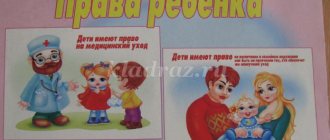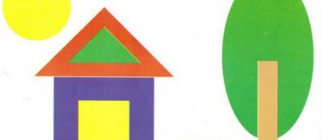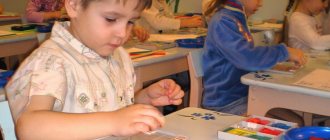- Tags:
- Recommendations from experts
- 3-7 years
- child's talents
At five years old, a child enters a special period of his life - senior preschool age. Psychologists call it basic, since during this period 90 percent of an adult’s personality traits are formed. He is already moving away from authority and full acceptance of the adult’s opinion; active processes of self-identification, which began at three years, continue. The baby develops his own opinion and his own view of the world. During this period, it is important for adults to find an approach to the child in order to maintain an emotional connection with him and help him take the first steps towards growing up.
Content:
- Age characteristics at 5-6 years old Differences between girls and boys
- Mathematics
- Games
Age characteristics at 5-6 years old
By the age of 5-6, the child has probably completely forgotten about his infancy and is constantly striving to learn something new.
Children at the age of 5 become more dexterous, their coordination improves, and the period of funny childhood clumsiness passes forever. Muscles are actively growing, vision becomes like that of an adult.
The main features of children at 5 years old:
- they run and jump well;
- deftly use cutlery and can cut food on their own, for example, make a sandwich;
- define themselves as a person;
- clearly express their gender identity. There are stereotypes about toys only for a certain gender. Boys, for example, defiantly avoid the doll section in the store;
- dress/undress themselves, know how to handle buttons and zippers, and can also tie shoelaces. However, if you bought your child only shoes with Velcro from infancy, then the skill of tying shoelaces will appear later.
Differences between girls and boys
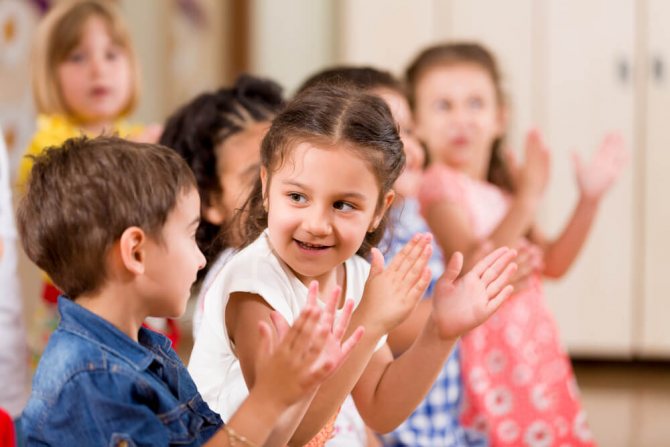
During this period, differences between boys and girls become noticeable. First of all, this can be seen in physical activity. As a rule, boys need more movement, while girls are calmer and more diligent.
At this age, boys and girls begin to speak and think differently. You are more likely to encounter richer grammatical structures when communicating with a girl than with a young man. In general, girls' vocabulary is about a year ahead of boys' vocabulary . Also, for young ladies, non-verbal coloring of speech is more important: tone and facial expression. Therefore, boys often find it more difficult to express their feelings and emotions. Their unexpressed grievances are transformed into aggressive behavior and fights with peers.
The most important thing that parents can do for a child at this age is to teach them to express their feelings. Now this is much more important than numerous circles and sections.
Cognitive development also differs between the two sexes. In addition to the fact that girls are more diligent, it is also easier for them to solve several problems at the same time. For boys, to achieve results, it is better to concentrate on one thing.
As for both sexes, 5 years is the age of amazing questions. And often the requests of the little “why” can make you blush or even drive you into a dead end. So, a daughter or son, being in a public place, may very loudly ask why their aunt has a big belly or why their uncle has dark skin.
Try to think through your answers to some questions, especially those related to sex education, in advance. Follow the rule: you should answer the question posed clearly and without details .
Checking readiness
It is important to understand that a 6-year-old child is not required to read and write quickly; this will come with time. But a good memory, vivid imagination, analytical skills and well-developed fine motor skills will help speed up this process.
The development of each child depends on his individual characteristics, but there are certain criteria that it is advisable to focus on in order to gradually fill possible gaps in education. Teachers and psychologists advise drawing up a portrait of a child’s personality by observing his behavior:
- in public places and at home;
- while talking with strangers and relatives;
- in relationships with friends and everyday communication with them.
It is also important to impartially assess the level of development of speech and word proficiency, the ability to express one’s thoughts and pronunciation of sounds.
The organization of any educational activities for children aged 5-6 years is unthinkable without an element of play. Although the purpose of teaching is to encourage the student to perform various tasks, it is better to do this in a creative atmosphere. We must not forget that at this age it is still difficult for a child to maintain attention on a specific task, and lessons should not last long.
It is better to study for 20 minutes a day with short breaks, combining solving puzzles with constructing crafts, graphic drawings and fun physical exercises. This will help develop the following qualities:
- concentration;
- the ability to switch from one type of activity to another;
- do several things at once.
What should a five-year-old child know and be able to do?
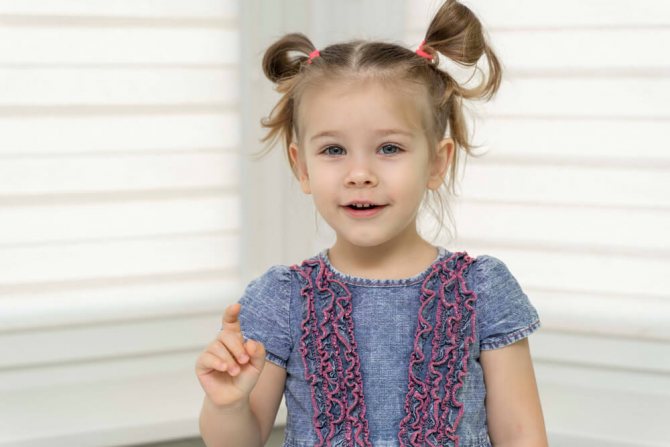
All children develop differently, but there are generally accepted standards that a child must meet at the age of 5 years. Check your grown-up child against the list compiled by the Federal State Educational Standard and try to eliminate gaps, if any. So, a 5-year-old child should:
Mathematics
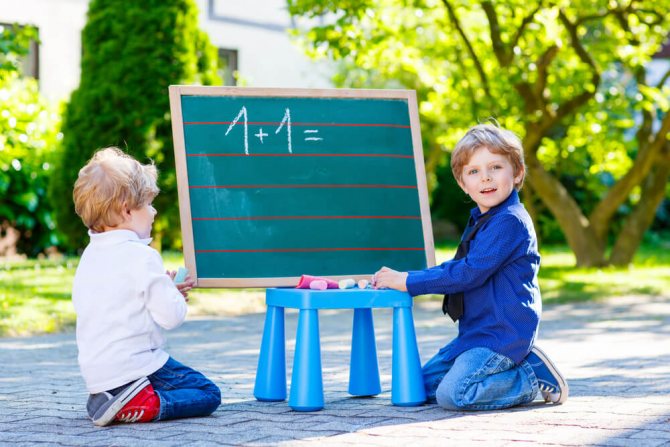
- Understand the meanings of “many” and “few”, compare different parts of a set, determine equality and inequality.
- Count from 0 to 5 and back.
- Answer the questions “How much?”, “Which one?”.
- Compare objects by size (length, height, width) and thickness (by overlapping).
- Know the name of the basic geometric shapes (square, circle, triangle, rectangle) and name their elements (angles, sides). Have ideas about a ball and a cube. Be able to correlate the shape of objects with these geometric figures.
Orientation in space
- Know and understand the main directions of movement.
- Know spatial relationships: far and near.
- Know the times of day and their sequence.
- Be able to explain the meaning of the words: “yesterday”, “today” and “tomorrow”.
Speech development
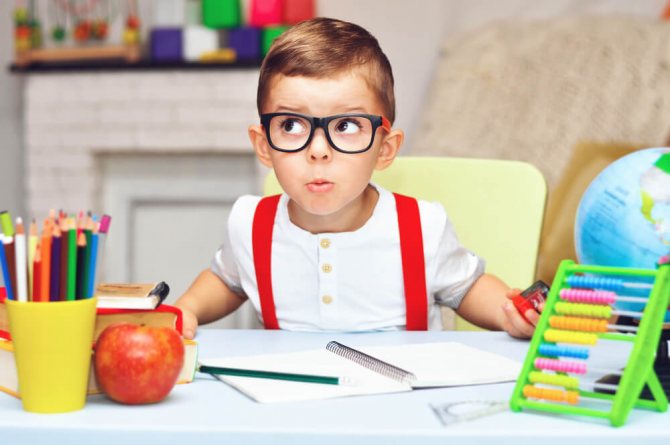
- The child’s vocabulary should contain about 1 thousand words, and phrases should consist of 6-8 words.
- Even strangers, not just parents, should understand children’s speech.
- The child must know how the human body differs from an animal: correctly name the parts of the body (hands - paws, hair - fur).
- Use the plural correctly.
- Guess the object based on its description and give it a description (apple: round, red, sweet).
- Know classes/groups of objects and combine them (for example, a chair and a sofa are furniture).
- Choose antonyms for words.
- Be able to tell how his day went.
- Know some proverbs and understand their meaning.
- Make up a story using pictures.
Intelligence and attention
- Find 5-6 differences between two pictures.
- Repeat a pattern or movement.
- Putting together a puzzle without adult help.
- Build according to the model from the designer.
- Be able to see incorrectly depicted objects in a picture and explain what is wrong and why.
A 5-year-old child strives for independence. He no longer identifies himself as “me + mom/dad,” but feels like a full-fledged person. In addition, now he can do many things more deftly: he can wash himself and brush his teeth, make himself a sandwich and get dressed for a walk.
Development of children 4-5 years old
Features of mental development of a child aged 4-5 years
At this age, the child's attention span increases. The child has access to concentrated activity for 15-20 minutes. He is able to retain a simple condition in memory when performing any action.
The child's imagination continues to develop. Its features such as originality and arbitrariness are formed. Children can independently come up with a short fairy tale on a given topic.
The child masters social norms of behavior. The content of communication between a child and an adult changes. It goes beyond the specific situation in which the child finds himself. The cognitive motive becomes the leading one.
Children develop a need for respect from an adult; their praise turns out to be extremely important for them. This leads to their increased sensitivity to comments.
Role interactions appear in the play activities of middle preschool children. They indicate that preschoolers begin to separate themselves from the accepted role. During the game, roles may change. Game actions begin to be performed not for their own sake, but for the sake of the meaning of the game. There is a separation between playful and real interactions of children.
Relationships with peers are characterized by selectivity, which is expressed in the preference of some children over others. Regular play partners appear. Leaders begin to emerge in groups. Competitiveness and competitiveness appear. The latter is important for comparing oneself with others, which leads to the development of the child’s self-image and its detailing.
It should be noted that at the age of 4-5 years, the shortcomings in raising a child begin to gradually take root and turn into stable negative character traits.
Logical thinking
A child aged 4 - 5 years should be able to:
- Without distraction, complete the task for 5-10 minutes.
- Find similarities and differences between objects. Find a pair for each item.
- Assemble a pyramid without outside help.
- Distinguish and name surrounding objects, their characteristics, purpose, materials.
- Classify objects, call a group of objects with a general word (apple, pear, banana - fruits; table, chair, sofa - furniture, etc.). Find the extra item in each group.
- Fold according to the model of a building from a construction set.
- Fold the cut picture into 3-4 equal parts.
- Remember 5-7 words out of 10 proposed; be able to remember pairs of words related in meaning after reading to an adult: winter-snow, cat-dog, etc.
- Find similarities and differences between objects.
Mathematics
A child aged 4 - 5 years should be able to:
- Distinguish and name parts of the day, seasons
- Know your right and left hand. Determine the location of objects: right, left, top, bottom, back, front, middle.
- Recognize and name the basic geometric shapes (circle, square, triangle, rectangle, ball, cube, cylinder), their characteristic differences.
- Find objects in the environment that are similar to familiar figures.
- The child must know all the numbers (0, 1, 2, 3, 4, 5, 6, 7, 8, 9). Count objects within five, correlate the number of objects with the desired number.
- Compare 2 groups of objects by making pairs.
- Understand the meaning: more - less, equally.
- Know the definitions: high, low, narrow, wide, more, less. Be able to compare 5 objects using these definitions, arranging them in ascending order by length, height, etc.
- The child becomes familiar with the graphic image of numbers and learns to write numbers correctly.
- Know and name at least 8 colors (6 primary and at least 2 shades).
Speech Development
A child aged 4 - 5 years should be able to:
- Understand the speech of others.
- Use from 800 to 1000 words in your speech, build phrases of 6-8 words. The speech must be understandable.
- Engage in dialogue: ask questions, answer questions.
- Find an item by description. Describe the item.
- Compose a simple descriptive story of 3-4 sentences based on a plot picture or a past event.
- Understand, use, form words - antonyms (warm - cold, low - high, etc.).
- Name nouns in singular and plural (pear - pears).
- Understand the meaning of prepositions (in, on, above, under, behind, between, before, about, etc.).
- Highlight the first sound in a word.
- Read short poems by heart.
- Answer questions meaningfully about the content of the work you read.
- Dramatize (retell) short fairy tales with the help of an adult.
The world
A child aged 4 - 5 years should be able to:
- Say your first and last name, how old he is, the city in which he lives, his country.
- Surnames, names, and professions of their parents.
- Understand the difference between the human structure and the structure of animals, name their body parts (hands - paws, nails - claws, hair - fur).
- Distinguish between vegetables, fruits and berries, know what they are like when they ripen.
- Distinguish between trees and shrubs. Identify trees by their bark and leaves. Know the conditions necessary for the growth and development of plants.
- Name domestic and wild animals and their young.
- Name insects, be able to talk about how they move (a butterfly flies, a snail crawls, a grasshopper jumps).
- Name what professions there are, what people in these professions do.
Fine motor and self-care skills
A child aged 4 - 5 years should be able to:
- Use cutlery (spoon, fork) correctly.
- Undress independently, dress with the help of an adult.
- Fasten buttons, zippers, untie laces.
- String large buttons or beads onto a thread.
- Hold a pencil correctly in your hand.
- Draw lines accurately without lifting the pencil from the paper.
- Shade the figures with even straight lines, without going beyond the contours of the drawing.
Visual activities
A child aged 4 - 5 years should be able to:
- Correctly hold a pencil, brush, felt-tip pen, colored chalk, and use them when creating an image.
- Depict objects, convey them expressively by creating distinct forms, choosing colors, and carefully painting.
- Convey a simple plot by combining several objects in a drawing, arranging them on the sheet in accordance with the content of the plot.
- Create a pattern on a circle or square.
- Create images of different objects and toys (consisting of several parts), combine them into a collective composition.
- Use all the variety of learned modeling techniques.
- Hold the scissors correctly and cut with them in a straight line, diagonally (square and rectangle), cut a circle from a square, an oval from a rectangle, smoothly cut and round the corners.
- Carefully paste images of objects consisting of several parts.
- Choose colors according to the color of the objects or at your own request.
- Make patterns from plant shapes and geometric shapes.
Physical development
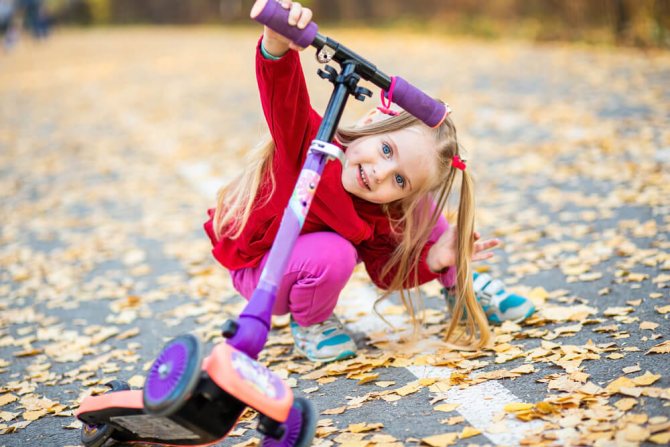
The first few years of a child's life are crucial for his physical development.
Height and weight at 5 years
Don't worry too much about your child's lack of appetite. If your son or daughter is developing normally, and you rarely visit the doctor, there is nothing to worry about. A child can grow by about 5 cm and gain about 2 kg of weight from the moment of their 4th birthday.
Here are some approximate parameters so you can estimate the height and weight of your child:
| Parameters/Gender of the child | Boys | Girls |
| Weight | from 16 to 21 kg | from 15.8 to 21.2 kg |
| Height | from 105.3 to 114.6 cm | from 104.7 to 114.2 cm |
⠀ Provide your child with the right daily routine, healthy eating, walk more in the fresh air, and then you will have no reason to worry about his height or weight.
Motor skills

5 years is the time when children's motor skills develop the most. Pay attention to the following stages of physical development of your 5-year-old child:
- deftly runs, jumps, climbs, kicks a ball, swings on a swing, because... by this age, coordination and balance will improve;
- can eat independently and at the same time carefully;
- can stand on one leg for about 10 seconds;
- walks forward and backward easily;
- rides a tricycle well.
5 years is the ideal age to start participating in sports clubs.
Fine motor skills
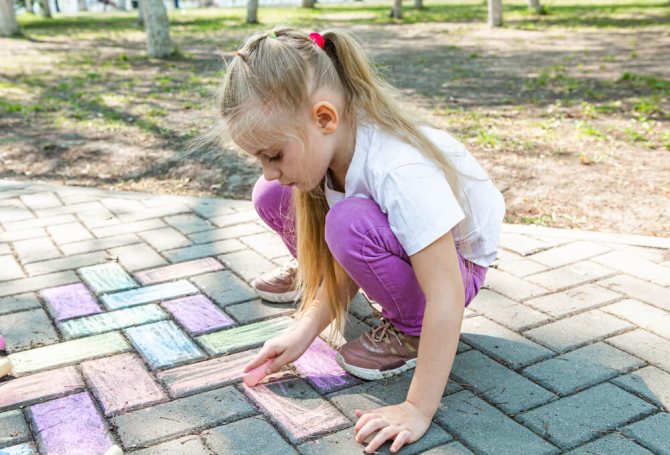
Children learn and experience the world through play. If there are no problems with fine motor skills, a 5-year-old child should be able to:
- build large towers from blocks/cubes;
- hold a pen/pencil well;
- be able to draw basic geometric shapes;
- deftly use a spoon and fork;
- dress/undress, use the toilet, brush your teeth without assistance;
- draw a person.
Advice. At 5 years old, a child is constantly improving his skills. To strengthen them, gradually make the task more difficult for him. For example, as your ability to use utensils improves, begin teaching your child good manners while eating.
Features of speech
Together with the child, his vocabulary grows, and his thought process becomes more advanced. We will not talk about the fact that lack of speech at 5 years old is an alarming sign. If there are existing problems, as a rule, at this age parents already know what they are dealing with and take care of their children’s health.
Development of language and communication
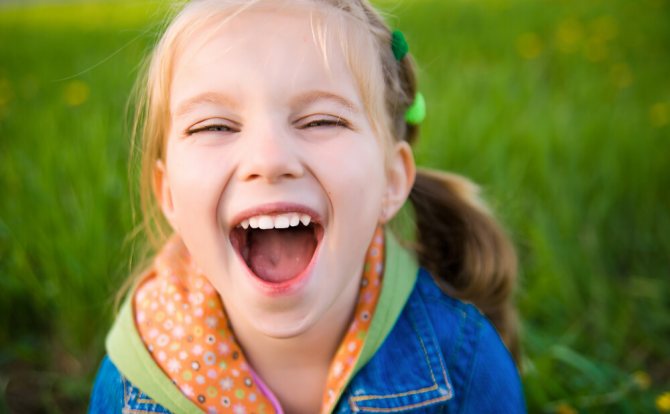
Your inquisitive “why” already knows how to conduct a conversation well and has the skills to communicate with people. Children aged 5 years not only answer simple questions easily and logically, but are already noticeably better at expressing their feelings. Most children at this age enjoy singing, rhyming, and making up words.
Good communication skills will help your child in the future, so it is important to ensure his proper language development.
Pay attention to the following stages of language development in your five-year-old:
- speaks clearly using complex sentences;
- correctly names basic colors and shapes;
- knows at least a few letters, perhaps even knows how to write a few words (for example, “mom”, “dad” and his name);
- understands the daily routine: breakfast in the morning, dinner in the evening, etc.;
- uses the future tense: “We will go to the park soon”;
- carries out assignments consisting of two or three parts. For example, “put away the book, wash your face and go to bed”;
- knows his address, home telephone number, surnames and names of parents, grandparents;
- can tell you how his day went.
The age period from 5 to 6 years is called senior preschool. From the age of five, a child must be prepared for future schooling. In the article we will consider the main features of the development of children of this age and give recommendations to parents so that this time of the child’s life can be used most effectively.
Physical development
At five years old, the baby’s movements become more confident and dexterous. The child jumps well in length and height, maintains balance, confidently climbs a gymnastic wall, rope or hanging ladder, deftly handles the ball and can jump rope, is well oriented in space, walks well on a narrow board, steps over and jumps over obstacles. And at the end of the fifth year, many children can already ride a two-wheeled bicycle.
He must be able to correctly use various symbols of spatial relationships: go down, turn right, reach a corner, go to the other side, etc. Five-year-old children are very active. For normal physical development, a child needs to move a lot. Some children at this age already begin to attend sports clubs.
Buy a few simple exercise equipment for home - a crossbar, rings, a gymnastic wall. Exercises should be done at the same time every day. It is advisable to come up with musical accompaniment for them. Numerous educational videos that can be downloaded on the Internet will tell you how to properly engage with your baby. Use walking time for sports games: let the child play ball and various outdoor games, run on the playground and race with peers, overcome obstacles.
Fine motor skills and household skills
By the age of five, fine motor skills are actively improving. Children know how to string beads and buttons on a string, sculpt various figures from plasticine, and play with complex construction sets. Preschoolers draw well, using brushes, pencils and felt-tip pens. Their pictures turn out to be quite recognizable. They hold the pen well and try to write in cursive. They can connect different dots on paper, try to make origami out of paper, and are good at putting together puzzles with a dozen pieces.
The development of fine motor skills is the main indicator of readiness to master writing, reading, correct speech and intelligence in general: the hands, head and tongue are connected, and any violations in this chain lead to a lag. Therefore, a normally developing child of six years old should be able and love to draw, sculpt, cut with scissors, use a needle, etc. Excellent tools for developing fine motor skills are the art of origami (creating various products from paper), as well as the art of tying knots from strings.
In everyday life, by the age of five, a child becomes completely independent. He eats with a spoon, knife and fork, and drinks from a mug. Knows the rules of table etiquette and does not throw food away. He washes himself, brushes his teeth and rinses his mouth. Dresses without assistance, knows how to fasten a zipper, tie shoelaces, fasten and unfasten buttons. Allow your child to improve his everyday skills, do not help unless necessary. Children who go to kindergarten often cope with everyday things much better than those who are raised at home.
Speech development
The vocabulary of a child aged five to six years is quite large and amounts to more than 3000 words. He pronounces most sounds, but has problems with the letter “r” and some sibilants. If any difficulties arise in the development of a child’s speech at this age, it is necessary to consult with a professional speech therapist, undergo diagnostics, receive recommendations for independent study at home, or start attending regular classes with a speech therapist at a children’s center. Therefore, it is so important that parents talk more with the baby, monitor their speech, pronounce words and phrases correctly, and avoid too loud sounds, since the child copies the speech of adults along with their mistakes.
The sentences a preschooler speaks usually consist of 5-6 words. The children's dictionary contains nouns in all cases, verbs, adverbs, short participles. The child uses all tenses, superlatives, diminutives, uses synonyms and antonyms, although he sometimes makes grammatical errors. Children aged five can independently form an adjective from a noun. Their speech is logically structured, they are able to communicate on abstract topics, retell fairy tales, capturing their main meaning, and independently recite poetry, actively using different intonations.
According to child psychologists, in the sixth year of a child’s life one should begin to teach reading. Most children of this age themselves show an interest in mastering literacy, especially if you constantly talked and played with your child, answered his questions and stimulated his cognitive interests, read a lot, learned poems and simple songs. Many parents and their children collect cubes with pictures for each letter of the alphabet: M - ant, I - apple, etc. You can also write the corresponding letter above each picture and every day, looking at the pictures, ask the child to name this letter . Children really like these activities.
To read aloud, choose bright, colorful books with interesting stories; "magic books" are very good for this purpose. Let the child choose the book himself. Sit him on your lap or next to you on the sofa, in an armchair, so that he can “read” with you. This is very important from the point of view of developing interest in the reading process, not to mention the fact that it brings you closer to each other emotionally. Teach your child not only to listen to readings, but also to retell in his own words what he heard. This way the child will better understand its content, learn to remember the events described in the book, and therefore his memory will improve.
Manual skills also contribute to speech development. It is very important to shape and strengthen the hand, especially the leading one. Even an intellectually developed and school-prepared child will not be successful in learning if his fine motor skills are not developed. All this will create further, secondary difficulties, affecting self-esteem and even attitude towards learning. Therefore, it is very important during this period to engage in all kinds of creative activities, learn to hold a pencil correctly and confidently, cut with scissors, make appliqués, design and sculpt. Get your child interested in creating something new and interesting. As you know, any creativity is also a therapy that allows you to relieve stress and recharge with positive emotions.
Mental development of a child of the sixth year of life (features of cognitive processes)
The attention of a child of this age period is characterized by involuntariness; he cannot yet control his attention and often finds himself at the mercy of external impressions. This manifests itself in rapid distractibility, inability to concentrate on one thing, and in frequent changes of activities. Additional activities that go beyond the scope of the task are difficult for the child. If a child is hyperactive, it is even more difficult for him to concentrate. He prefers outdoor games and cannot sit in one place for more than five minutes.
An adult's guidance should be aimed at the gradual formation of voluntary attention, which is closely related to the development of responsibility, which is so necessary for a child in the process of schooling. This involves carefully completing any task - both interesting and not very interesting to the baby.
A child’s perception develops literally from the first months of life. By the age of five or six, a child can usually distinguish colors and shapes of objects well. The child is well oriented in space and correctly uses a variety of symbols of spatial relationships. More difficult for a child is the perception of time - orientation in the time of day, in assessing different periods of time. It is still difficult for a child to imagine the duration of any task.
In five-year-old children, visual-figurative thinking predominates. They understand well how many household appliances work and how they can be used. Toys are not broken, but disassembled into parts. They quickly learn to use new objects during the game. Verbal and logical thinking is just beginning to form. Children can already make the first generalizations, sort objects according to their characteristics, create logical chains and find unnecessary objects in them. But many abstract concepts are still inaccessible to them; they have difficulty grasping the logic of words if they are not supported by material objects. By the age of five or six, the child uses such mental operations as generalization, comparison, abstraction, and establishing cause-and-effect relationships. Thanks to this, the child can understand the main idea of a fairy tale, picture, combine several pictures based on a common feature, sort pictures into groups based on an essential feature, etc.
Classes with a child from parents, teachers or psychologists can improve thinking indicators by 3-4 times. It is important that the tasks set do not exceed the child’s capabilities, but are based mainly on motivation for success. Now there are many bright and exciting encyclopedias, board games and educational toys that can captivate a child. For example, a series of reading books with 4 levels of difficulty. Each book is a small encyclopedia, which contains facts on various topics, ranging from everyday life to scientific ones. The child will gain an understanding of space, the ancient world, the human body, animals and plants, countries, inventions and much more. Various games, construction, modeling, drawing, reading develop in the child such mental operations as generalization, comparison, abstraction, and establishment of cause-and-effect relationships. Thanks to this, the child can understand the main idea of a fairy tale, picture, combine several pictures based on a common feature, sort pictures into groups based on an essential feature, etc. Thanks to the development of verbal and logical thinking, the child becomes able to understand the connections of objects and phenomena that cannot be represented in visual form. This makes it possible to talk about them abstractly. Therefore, the game material becomes more complicated, it becomes logical, intellectual, and the child has to think and reason.
In a child of the sixth year of life, memory is still involuntary, based on emotions and interest, that is, the child easily remembers what interests him. But even in this case, forgetting occurs very quickly. Already at this age, individual differences appear: some children have better developed visual memory, others have better auditory memory, others have better emotional memory, and others have better mechanical memory. In activities with a child, one should develop all types of memory, but still strive to teach memorization based on mental activity and understanding.
Emotional and social development of five-year-old children
By the age of five, children learn to control their emotions, and they are already quite good at it. Psychological development reaches a level when it is easier for a child to evaluate his actions and restrain impulsive desires. Now he speaks well and can express whatever he wants in words. Therefore, the baby begins to feel more confident, because everyone understands him. Children's perseverance and patience improves. They can calmly wait their turn, ask permission to take this or that thing. The child can still be shy with strangers, but it is much easier to make contact than before. Children prefer group games to individual ones. They know how to share their toys and treat each other with goodies. During the game, they adhere to the rules and give in to each other if necessary. Now they have a sense of justice, they try not to offend their peers in vain.
By the age of five, the child learned to help his parents around the house and does it with pleasure. He continues to copy their behavior, so you shouldn’t expect the child to do things that mom and dad don’t do. At this age, the baby’s personality and habits are formed. It is important to lay down in the next two years all the skills that will be useful in adult life. Teach your preschooler to take initiative, give him the opportunity to choose. For example, when you go outside, ask what your baby wants to wear. The choice should be clear, between 2-3 things. His self-esteem will increase, the preschooler will feel like an important person. At the same time, he will develop a sense of responsibility for his choice.
Game Features
The formation of voluntary behavior in the period of 5-6 years is facilitated by play, which is still the leading activity for the child, the main component of his mental development. Now, the role-playing game is reaching its peak, and relationships between people become its content. Children themselves create models of these relationships, forming stable associations of 3-4 people or more. This game contains many actions that help the child build role-playing relationships with other participants. Thus, children become able to consciously plan and perform complex sequential actions. Children of this age have a very developed imagination; while playing, they imagine themselves as pilots, doctors, or fairy tale heroes. They sometimes invent friends for themselves and are afraid of monsters that exist only in their imagination. It happens that a child deceives adults and tells stories that did not actually happen. There is no need to worry that your baby is lying. To develop his creative abilities, independence, and initiative, he must go through a stage in life when fantasies are mixed with reality.
Regime and nutrition of a child at 5 years old
For normal growth and development, a child at five years old needs to eat properly. His table fully corresponds to the table of adults. If you yourself adhere to the rules of healthy eating, you may not prepare separate meals for your baby. Make sure he doesn't eat too much fried or smoked food. Snacking should not be encouraged; it is best when the child eats 4 times a day and at the same time.
In a year, the preschooler will become a schoolchild, which is why it is so important to accustom him to a routine now. Children should go to bed on time, no later than nine o'clock in the evening. Start your morning with hygiene procedures, gymnastic exercises and a full breakfast. It is advisable for the baby to wake up, wash and eat at the same time. Then you need to devote time to various activities with the child, which should take place in the form of a game, but at the same time, you should train the perseverance and attentiveness of the preschooler. After classes, you should definitely go for a walk with your child. Many children no longer sleep during the day by the age of five. But if your baby likes to take a nap after lunch, this is not a deviation from the norm, his nervous system just requires more rest. Evening activities should not be as intense as morning ones - play educational games or read a fairy tale.
Thus, preschool education for children should be interesting and educational. You should not pay attention only to intellectual pursuits all the time. We must not forget that physical exercise is no less important for a child. Approach education comprehensively - harmonious development will help your child successfully move to a new stage of life at school and be happy later.
Cognitive development
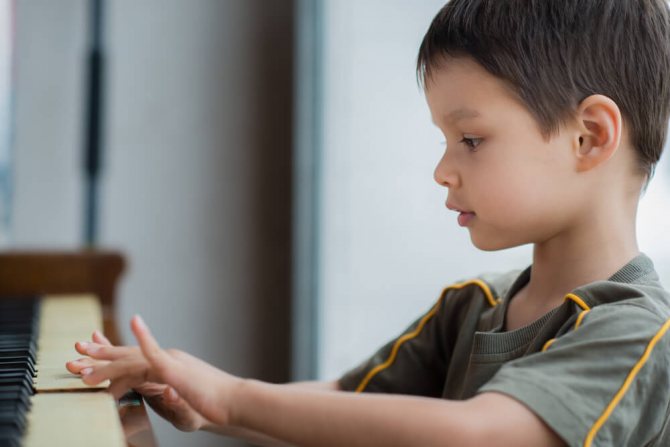
Cognitive development is an indicator that a child is developing thinking, logic and memory. Children already understand the difference between “right” and “wrong”, “good” and “bad”. At this age, they think and express themselves at a higher level.
Knowing the basic rules of behavior and the ability to follow them is an important stage in the development of a child.
At the age of 5, a child’s cognitive skills already allow him to begin teaching him to read and write. His memory and attentiveness become more perfect, which means that the learning process will not cause difficulties.
Remember that at the age of 5 all the gaps and shortcomings in upbringing begin to take root and turn into negative character traits of the child.
Memory
Memory plays an important role in children's development, as well as future school performance. Train this skill in your child: learn songs and rhymes, read to him more - now is the best time to replenish his vocabulary.
Thinking
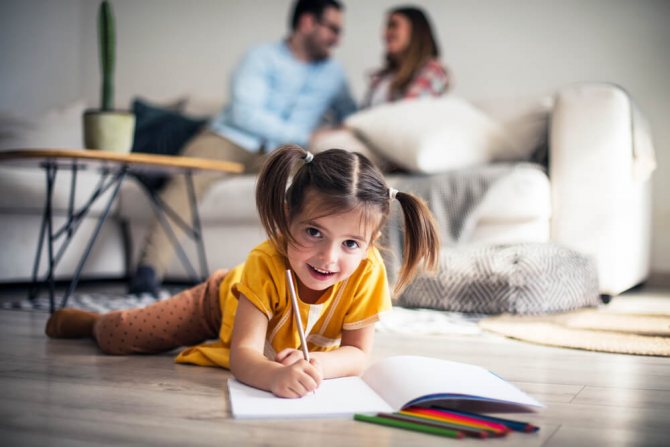
At 5 years old, your child better understands the opinions and attitudes of others. This helps him make friends and meet new people.
At this time, children's fears actively manifest themselves. The child is separated from his parents and feels insufficiently protected in the big world. To overcome this, he uses fantasy. However, the unrestrained “magical” thinking can give rise not only to new fears, but also to imaginary friends or protectors. Parents need to devote enough time to their children during this period.
Speech development at 5 years
At this age, the child’s speech is increasingly approaching the speech of an adult. A 5-year-old child should be able to correctly construct sentences, decline parts of speech, use suitable prepositions and the correct tense. Five-year-olds are quite capable of making compound and complex sentences using conjunctions “a”, “and”, “but”, “so that”, “because”, “if”.
For the development of a child’s speech, his environment is important: communicate with the baby, read fairy tales, listen to songs. Only emotional experience associated with the native language will help the child reveal its fullness and richness.
The vocabulary of a 5-year-old child has about 2 thousand words, which also include abstract concepts. Typically, five-year-old children can easily compose a story, describe the properties of an object, and evaluate some actions. The quality of sound pronunciation also improves. It happens that at this age children do not pronounce some sounds (usually “r”, “l”), in this case it is recommended to seek help from a speech therapist.
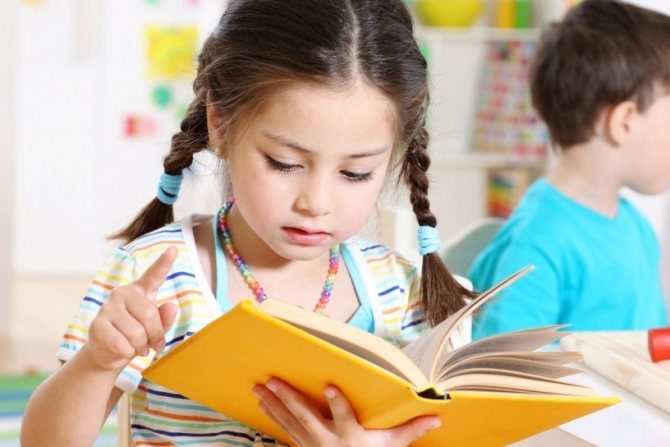
Five-year-old children are most often ready to learn to write and read. The level of readiness is determined by the development of the following skills:
- Ability to listen carefully;
- Recognize sounds;
- Build phrases;
- Ability to hold a pencil.
Cognitive motivation is very important. The child should be interested in finding out what is written on that sign and how this word is spelled. Without this, learning to read and write can turn into torture for a child.
Emotions and social skills
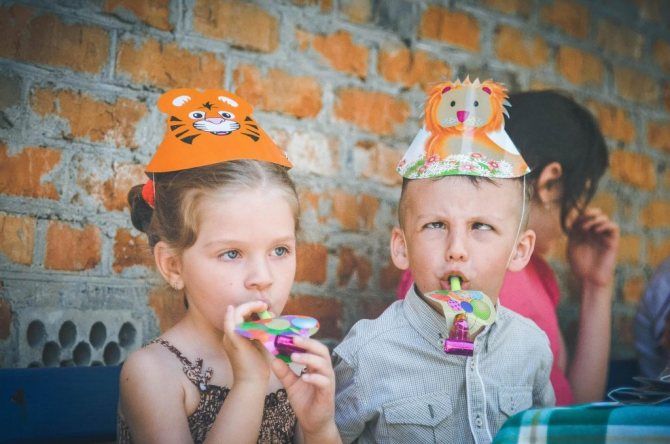
5 years is a period of emotional extremes. Either you notice that your child has better control over himself, then suddenly he begins to “play” at being little and seems completely helpless.
During this time, children learn to control their emotions, although they may burst into tears over an overturned glass of water. It is important to teach your child to understand his feelings and cope with them. At the same time, “coping” does not mean suppressing negative emotions.
A five-year-old child can already consciously sympathize with another or share his problems with someone.
Check how well your son or daughter's emotional and social development complies with generally accepted norms:
- periodically the child tries to please people;
- can distinguish reality from fantasy;
- may be more independent;
- realizes that society has its own rules that must be followed;
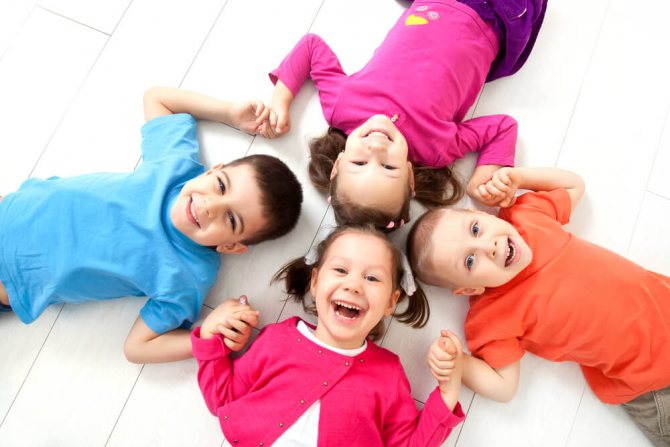
Your child can become more sociable if he starts going to kindergarten and meets more children.
Psychology of a five-year-old or how to raise a happy preschooler

At 5 years old, children understand much more than we think. Another thing is how the child reacts: discusses what he saw with his parents or draws his own conclusions. It is important to have a trusting relationship with your child.
The child's psyche cannot tolerate physical and harsh punishment. Insults will cause just as much harm. At 5 years old, a child is able to listen to an adult and analyze his mistake with him.
During this period, it is very important not to give long lectures to children and try to prohibit as little as possible. Offer an alternative. For example, you can’t hit a ball against walls at home, but you can hit it on the street. Or: you can’t draw on wallpaper, but you can on a sheet of paper.
Be sure to spend time with your child every day . Even if it’s just 15 minutes after work in the evening, it’s just your time without gadgets and the rest of your household.
Developmental Level Test for 5 Year Olds
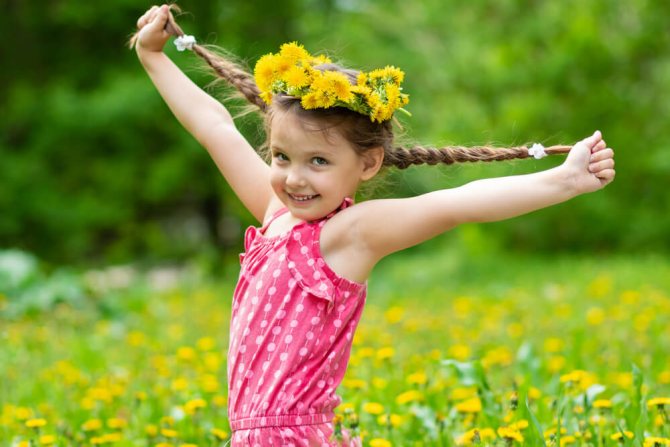
To find out the level of development of your child, we offer the simplest and fastest test. Ask your son or daughter to complete 5 tasks:
- Name the seasons and days of the week (it would be ideal if the child names them in order).
- “Why do people brush their teeth every day?” A child is considered to have given an answer if he backs it up with a good explanation or facts.
- Say out loud clearly any 5 simple words. Ask your child to repeat them from memory.
- Ask to explain why an item is needed (kettle, paints, etc.). The child will receive credit for the question for answering in 3-4 detailed sentences.
- Draw 3-4 broken lines on paper. Show them to your child, then remove the sheet and ask your son or daughter to draw the same lines. For children aged 5 this should not be difficult.
If your child has completed only 3 tasks or less , try to work with him more and develop him. Pay attention to his memory and thinking habits.
4 correct answers is a good result. You can try to test your child again later, perhaps something was distracting or bothering him.
If your child passes the entire test quickly and without errors, you have nothing to worry about!
Time management. Our schedule (5-6 years)
Hello, dear readers, guests, friends. Today I will continue my story about my time management. Last time, I tried to structure information about how, in my opinion, to correctly determine the priority areas of a child’s development and how to create a schedule for different periods of a child’s life, so that this very development can be brought into the life of mother and child.
Last time, I also promised to talk in detail about how we live now and what our rhythm of life is, since this question worried almost all my readers who sent me their questions.
So, what makes this year so special? This is our last year before school. And on September 1, 2015, Dasha will become a first-grader (I hope that nothing will interfere with this). Therefore, the main goal we have set this year is to prepare well for school. I planned to cook Dasha at home + take her to the preparatory class at the school that I had chosen so that she could get to know her future teacher (and she with her) better, so that Dasha would get used to the atmosphere of the lesson and the school itself. But it so happened that the preparatory class had to be canceled, since it completely coincided in time with our choreography classes, and Dasha really asked us not to give up choreography. I listened to her, and we did not go to preparatory class.
When compiling our schedule this year, classes at the art school and the English language came to the fore (by the way, Dasha herself asked to start studying last year, but we had big problems finding a tutor and only at the beginning of summer this year we managed to solve it). All our other plans are already being made taking into account these very activities.
Dasha attends choreography classes 2 times a week in the evenings (Mon and Wed), on Thursday she has music and drawing, on Tuesday and Sunday English with different tutors (it would take a long time to explain the reason for combining two tutors, but believe me, this was the case in our case more convenient and efficient). Accordingly, we still have our favorite Friday. Favorite because it's in a museum. We try to go on excursions and walks on Fridays (but not every week). We try to spend weekends outdoors with the whole family.
It turns out that we always have plans for the evening, and the whole day is at our disposal.
Dasha wakes up from 7-8 in the morning and goes about her business: draws, plays, reads, etc. Around the same time, dad wakes up, feeds Dasha and leaves for work. As soon as the door closes behind dad, Dasha wakes me up and our day begins (on average it’s 9 am). Since it’s difficult for me to get up right away, especially in winter, we just cuddle and fool around in bed for a while. Then I make a Herculean effort and stand up
